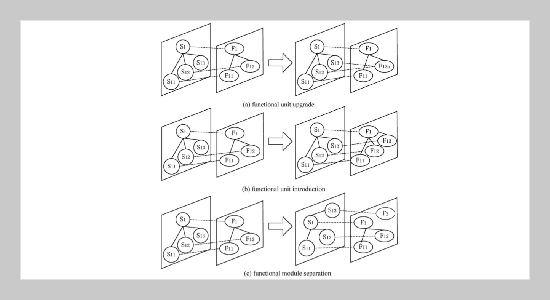REFERENCES
- [1] Jiao, J. R., Simpson, T. W. and Siddique, Z., “Product Family Design and Platform-based Product Development: a State-of-the-art Review,” Journal of Intelligent Manufacturing, Vol. 18, No. 1, pp. 529 (2007). doi: 10.1007s10845-007-0003-2
- [2] Hou, L., Tang, R. Z. and Xu, Y. S., “Review of Theory, Key Technologies and its Application of Modular Product Design,” Chinese Journal of Mechanical Engineering, Vol. 40, No. 1, pp. 5661 (2004). doi: 10.3901 JME.2004.01.056
- [3] Browning, T. R., “Applying the Design Structure Matrix to System Decomposition and Integration Problems: a Reviewand New Directions,” IEEE Transactions on Engineering Management, Vol. 48, No. 3, pp. 292306 (2001). doi: 10.1109/17.946528
- [4] Whitfield, R. I., Smith, J. S. and Duffy, A. H. B., “Identifying Component Modules,” 7th International Conference on Artificial Intelligence in Design, Cambridge, U.K., Jul. 1518, pp. 1517 (2002). doi: 10. 1016/j.compind.2004.10.002
- [5] Hsiao, S. W. and Liu, E., “A Structural Componentbased Approach for Designing Productfamily,” Computersin Industry, Vol. 56, No. 1, pp. 1328 (2005). doi: 10.1016/j.compind.2004.10.002
- [6] Helmer, R., Yassine, A. and Meier, C., “Systematic Module and Interface Definition Using Component Design Structure Matrix,” Journal of Engineering Design, Vol. 21, No. 6, pp. 647675 (2008). doi: 10.1080/ 09544820802563226
- [7] Yu, T. L., Yassine, A. A. and Goldberg, D. E., “An Information Theoretic Method for Developing Modular Architectures Using Genetic Algorithms,” Research in Engineering Design, Vol. 18, No. 2, pp. 91109 (2007). doi: 10.1007/s00163-007-0030-1
- [8] Beek, T. J. V., Erden, M. S. and Tomigama, T., “Modular Design of Mechatronics Systems with Function Modeling,” Mechatronics, Vol. 20, No. 8, pp. 850863 (2010). doi: 10.1016/j.mechatronics.2010.02.002
- [9] Li, Z., Cheng, Z., Feng, Y. and Yang, J., “An Integrated Method for Flexible Platform Modular Architecture Design,” Journal of Engineering Design, Vol. 24, No. 1, pp. 120 (2013). doi: 10.1080/09544828.2012. 668614
- [10] Erixon, G., Yxkull, A. V. and Arnstroem, A., “Modularity-the Basis for Product and Factory Reengineering,” Annals of the CIRP, Vol. 45, No. 1, pp. 16 (1996). doi: 10.1016/S0007-8506(07)63005-4
- [11] Ji, Y., Chen, X. and Qi, G., “Modular Design Involving Effectiveness of Multiple Phases for Product Life Cycle,” International Journal of Advanced Manufacturing Technology, Vol. 66, No. 9, pp. 14751488 (2013). doi: 10.1007/s00170-012-4432-5
- [12] Li, Y., Chu, X., Chu, D. and Liu, Q., “An Integrated Module Partition Approach for Complex Products and Systems Based on Weighted Complex Networks,” International Journal of Production Research, Vol. 52, No. 15, pp. 46084622 (2014). doi: 10.1080/00207543. 2013.879617
- [13] Song, Z. and Kusian, A., “Mining Pareto-optimal Modules for Delayed Product Differentiation,” European Journal of Operational Research, Vol. 201, No. 1, pp. 123128 (2010). doi: 10.1016/j.ejor.2009.02.013
- [14] Gao, F., Xiao, G. and Simpson, T. W., “Identifying Functional Modules Using Generalized Directed Graphs: Definition and Applications,” Computers in Industry, Vol. 61, No. 3, pp. 260269 (2010). doi: 10.1016/j.compind.2009.09.007
- [15] Stone, R. B., Wood, K. L. and Crawford, R. H., “A Heuristic Method for Identifying Modules for Product Architectures,” Design Studies, Vol. 21, No. 1, pp. 531 (2000). doi: 10.1016/S0142-694X(99)00003-4
- [16] Chandrasekaran, B., Stone, R. B. and Mcadams, D. A.,“Developing Design Templates for Product Platform Focused Design,” Journal of Engineering Design, Vol. 15, No. 3, pp. 209228 (2004). doi: 10.1080/ 09544820410001647078
- [17] Gao, F., Xiao, G. and Pan, S., “Method of Product Function Module Partition,” Chinese Journal of Mechanical Engineering, Vol. 43, No. 5, pp. 2935 (2007). doi: 10.3901/JME.2007.05.029
- [18] Martin, M. V. and Ishii, K., “Design for Variety: Development Standardized and Modularized Product Platform Architectures,” Research in Engineering Design, Vol. 13, No. 4, pp. 213235 (2002). doi: 10.1007/ s00163-002-0020-2
- [19] Ji, Y., Qi, G. and Gu, Q., “Lifecycle Data Model & its Evolvement for Product Family,” Computer Integrated Manufacturing Systems, Vol. 13, No. 2, pp. 213235 (2007).
- [20] Xu, X., Gao, L. and Fang, S., “Product Family Architecture Evolution Based on Technology Evolution Theory of TRIZ,” Proc. of World Congress on Intelligent Control and Automation, Chongqing, China, Jun. 2527, pp. 56625666 (2008). doi: 10.1109/WCICA. 2008.4593853
- [21] Kivi, A., Smura, T. and Töyli, J., “Technology Product Evolution and the Diffusion of New Product Features,” Technological Forecasting & Social Change, Vol. 79, No. 1, pp. 107126 (2012). doi: 10.1016/j. techfore.2011.06.001
- [22] Park, K. and Kremer, G. E.O., “A Network Based Dynamic Model for Product Family Evolution,” Proc. of the ASME International Design Engineering Technical Conferences, New York, U.S.A., Aug. 1720, pp. 18 (2014). doi: 10.1115/DETC2014-35446
- [23] Hou, L., Wang, H. and Mu, R., “Research on the Evolution & Innovation for Modular Product Family,” Chinese Journal of Mechanical Engineering, Vol. 48, No. 12, pp. 5564 (2012). doi: 10.3901/JME.2012.11. 055
- [24] Wu, Y., Hou, L. and Zhu, Q., “Analysis and Evaluation for Core Module Based on Product Family,” Transactions of the Chinese Society for Agricultural Machinery, Vol. 45, No. 4, pp. 294302 (2014).
- [25] Fey, V. and Rivin, E., Innovation on Demand: New Product Development Using TRIZ, Cambridge University Press (2005).
- [26] Pahl, G. and Beitz, W., Engineering Design: a Systematic Approach, Springer-Verlag, London (2007)
















